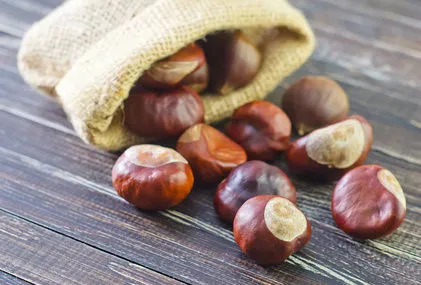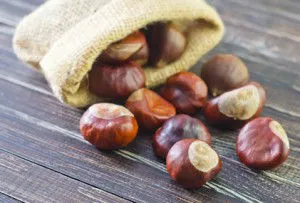
- Share on Facebook69
- Share on Pinterest
- Share on Twitter
You’ve probably heard the song which includes the lyric, “Chestnuts Roasting on an Open Fire.” This year, instead of just singing along, you might want to roast some of your own. They have a sweet, mild flavor, a crumbly texture, and are most plentiful during the winter. Here are just a few chesnut facts to warm you up to them this season.
Chestnuts are high in fiber to support better digestive health
Chestnuts are an excellent source of fiber which helps to reduce cholesterol and stabilize blood sugar levels while also aiding digestive disorders. Eating chestnuts can help reduce the risk of intestinal complications such as diverticulosis in which small pockets on the intestinal wall lining become inflamed.
Chestnuts boost brain power
Chestnuts are rich in B vitamins which help produce red blood cells as well as to break down protein, carbs and fat for energy, promote healthier skin and improve brain functioning. Just a 3-ounce serving contains 21 percent of the recommended daily value of B-6 and other important B-complex vitamins like thiamine, riboflavin and folate.
Chestnuts battle free radicals
Chestnuts offer a high content of manganese, which is an antioxidant that helps to battle free radicals and reduce the risk of heart disease and cancer, in addition to playing a key role in slowing the aging process. This trace mineral also helps the body with connective-tissue production and blood clotting.
Chestnuts strengthen bones
Another trace mineral found in chestnuts is copper, which helps boost the immune system and strengthen bones. The body needs just a small amount to run efficiently, and chestnuts contain 22 percent of the recommended daily value in a 3-ounce serving. They are also quite rich in vitamin C, which is essential for teeth formation as well as bones and blood vessels.
Chestnuts contain healthy fats
Chestnuts are also a good source of healthy monounsaturated fats, including oleic acid and palmitoleic acids. Foods that contain healthy fats help keep you fuller longer, in addition to helping lower total cholesterol and LDL, or bad, cholesterol and raising HDL, or good, cholesterol.
How to roast your own
If you want to roast your own chestnuts, an open fire is not really required. Here’s how you can cook them:
Preheat oven to 425 degrees Fahrenheit. While the oven is preheating, wipe the chestnuts off with a damp towel and set them on a cutting board with the flat side down. Using a small, sharp knife, cut an “X” into each one to allow steam to escape while cooking and then place them into a baking pan with the “X” face up.
 Place them in the oven for 20-30 minutes, or when the shells burst open and the chestnuts are golden brown. Next you’ll need to peel them while they’re still warm, but not so hot that they burn your fingers.
Place them in the oven for 20-30 minutes, or when the shells burst open and the chestnuts are golden brown. Next you’ll need to peel them while they’re still warm, but not so hot that they burn your fingers.
In some places, like New York City, roasted chestnuts may be available in the winter through a street vendor, which is an infinitely easier way to enjoy their deliciousness and numerous health benefits!
-The Alternative Daily
- Share on Facebook69
- Share on Pinterest
- Share on Twitter

